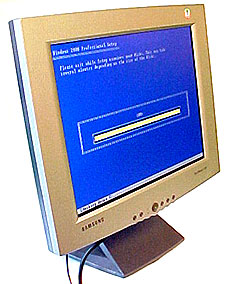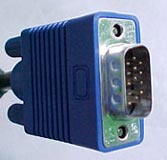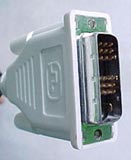|

|
For those of you who have lay awake at night dreaming of a flat screen in place of that bulky cube of a CRT display this may be the monitor for you.
87% Rating: 
|
|
|
|
Home >
Reviews >
Monitors >
Samsung 170T |
|
|
Samsung SyncMaster 170T TFT Display
The size difference between a 18.1" TFT display
and a 17" TFT display is really slight, but cost wise it can be quite significant. For those of you who have lay awake at night dreaming of a flat screen in place of that bulky cube of a CRT display this may be the monitor for you. Samsung's Syncmaster 170T is sleek, silvery, and most of all dead flat. Measuring less than three inches thick, the panel can be removed from the base and mounted to a wall, or even a moveable armature.
 With the flexibility for both DVI and Analog inputs the display is future proof and adaptable to today's high-end analog video cards, either in a single or dual
computer configuration. Blessed with dual inputs, the 170T maintains the functionality necessary to connect simultaneously to two computers (one using the analog, and the other the digital
input) and switch between them with the touch of a button. The Syncmaster features
a 1280x1024 resolution which makes it comparable to most 19" displays in size. Naturally, image quality is the most important facet of any display, whether it be flat, curved or projection -
the 170T won't disappoint. With the flexibility for both DVI and Analog inputs the display is future proof and adaptable to today's high-end analog video cards, either in a single or dual
computer configuration. Blessed with dual inputs, the 170T maintains the functionality necessary to connect simultaneously to two computers (one using the analog, and the other the digital
input) and switch between them with the touch of a button. The Syncmaster features
a 1280x1024 resolution which makes it comparable to most 19" displays in size. Naturally, image quality is the most important facet of any display, whether it be flat, curved or projection -
the 170T won't disappoint.
TFT displays like the 170T offer users a very crisp and geometrically accurate picture. Problems with picture geometry that we often associate with CRT displays are a thing of the past. The real challenge for TFT displays is to maintain a bright and high-contrasting display that refreshes quickly, and vividly during the most mundane tasks and the most intense
graphical challenges. The LCD panel carries itself well with a 0.281mm dot pitch (best we've seen is 0.264mm) and boasts a very nice contrast ratio of 350:1. So bolt on that Kensington
lock and get ready to go!
| Samsung
SyncMaster 170T Display: |
 |
17" Diagonal
Viewable Size (a-si TFT active matrix display)
Dot pitch of
0.281mm
Contrast Ratio: 350:1
Luminance: 220cd/m2
Viewing Angles: 80/80/80/80
(up/down/left/right)
Consumes
40Watts power
1280x1024 pixel
resolution, analog
and DVI connection
Weighs approx. 8.4Kg
External universal power supply
(100-240 Volt AC)
Comes with: CD-ROM, 6 foot power cord, 15-pin D-sub analog video
cable, DVI video cable, manual, AC-adaptor.
Manufacturer:
Samsung |
| pixel pitch |
luminance |
contrast |
viewing angle |
response time |
resolution |
|
0.281mm |
220cd/m2 |
350:1 |
80/80/80/80 |
25ms |
1280x1024 |
Important info about buying a TFT
display
We always suggest you test any flat panel
display you are considering in the store before you pay for it!
LCD
panels are very complex components and in the past many manufacturers only guaranteed
their display's to be 99.9% free from defect. That could mean up to 3 or 5 broken
pixels before the display is considered "broken." Broken pixels are individual
pixels in the display panel which are stuck on a certain colour, are constantly
dim, or are always off. Depending on the location and intensity of a broken pixel
they can be next to invisible, or glaringly obvious. It pays to test the
display first, regardless of which manufacturer makes it.
Analog and DVI
Analog video connections are the type of video cable most
commonly in use at the moment. In the future this may change, but for the
moment there are still a heck of a lot of people holding on to their
old 17" CRT displays. When the price of LCD's comes down to the sub $400
level I would expect DVI to become more dominant.
| Analog Connection |
DVI Connection |
 |
 |
The basic differences between an analog display adapter and a DVI (digital) display adapter
(besides the blue and white colors) is that with the blue analog cable the image is transmitted to
your monitor as an analog signal. On the other it arrives at the display
as a digital stream of one's and zero's.
When these display
signals are sent to an LCD display
- a device which only operates in the digital realm -
the picture must translated to a digitally signal before it can be processed and
displayed. On the other hand, if you happen to be equipped with a digital output on your
video card, the digital signals are simply sent right to the display to be
shown on the screen as they were intended.
Is there a difference between the two means of connecting a display?
No... not really. On the visual level there hasn't ever been a perceivable difference
in display quality that I could actually see.
|
|
|
|

